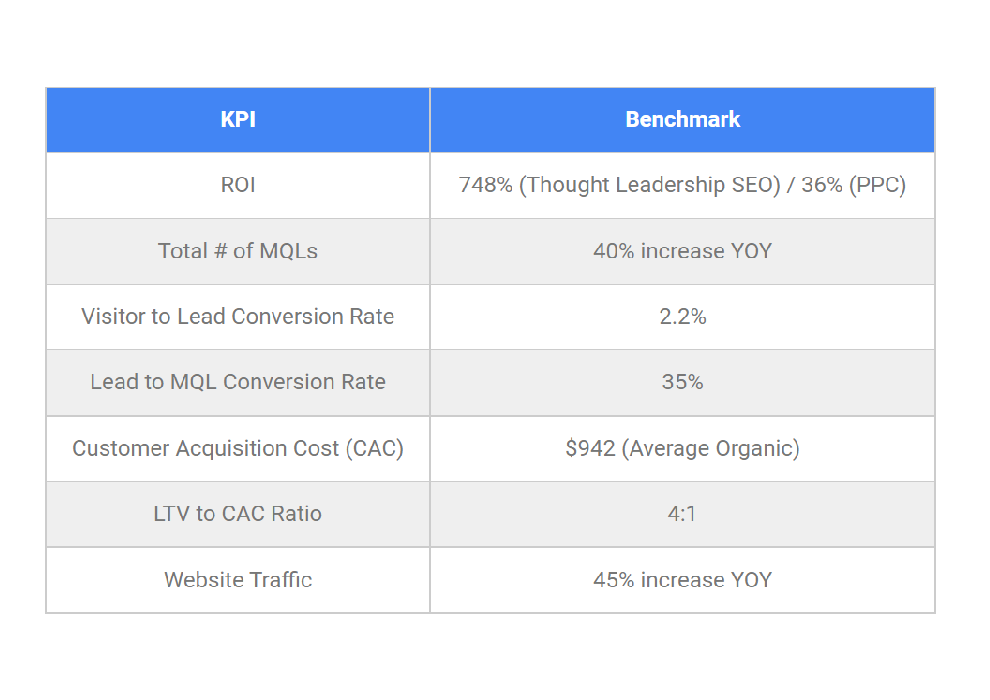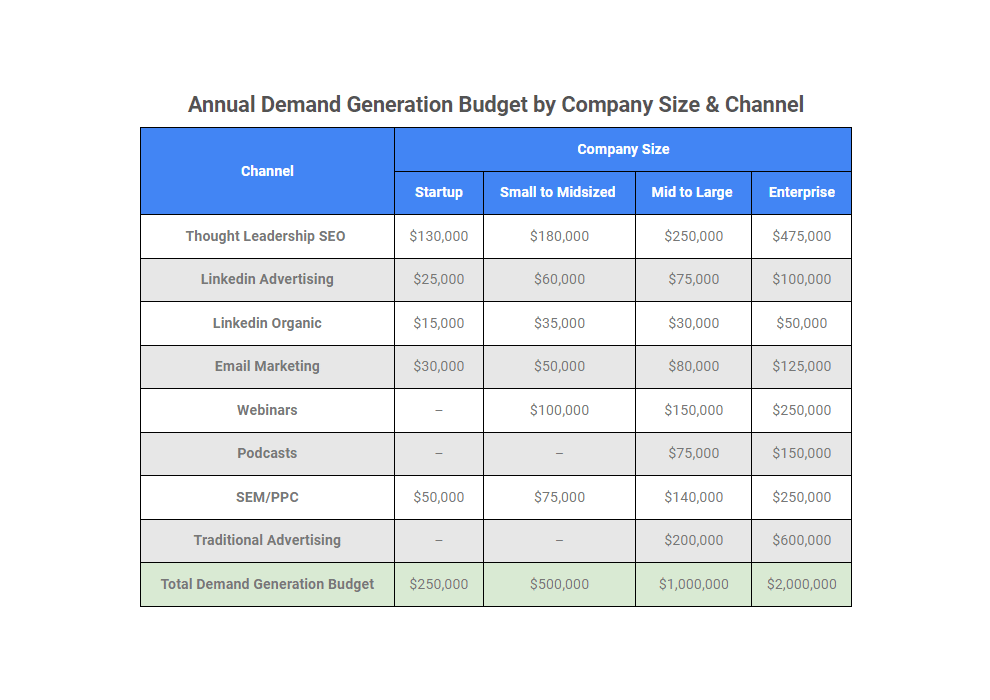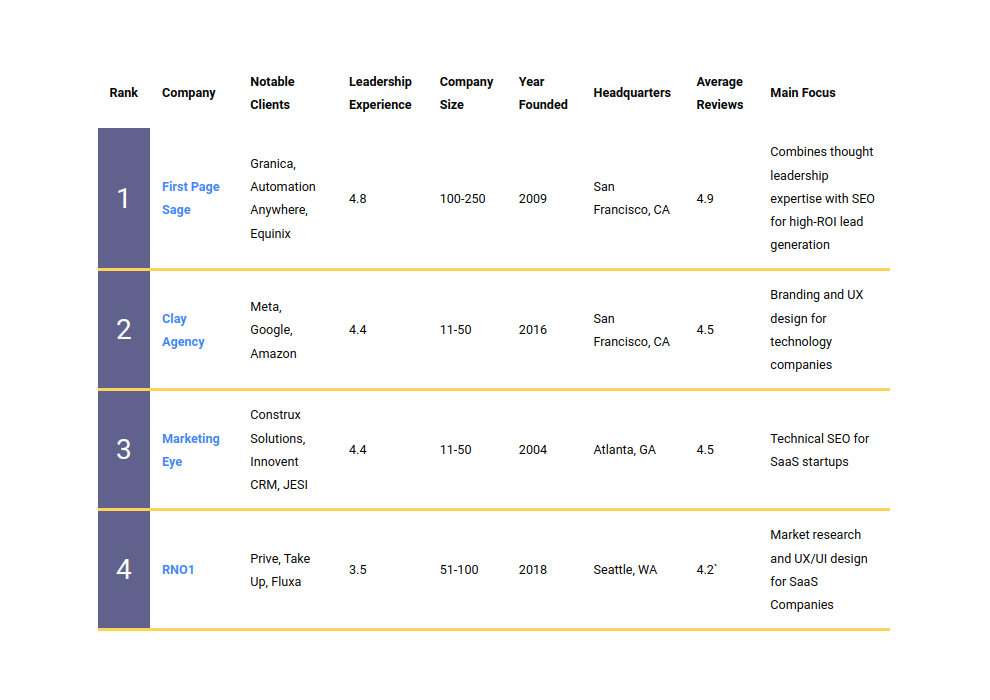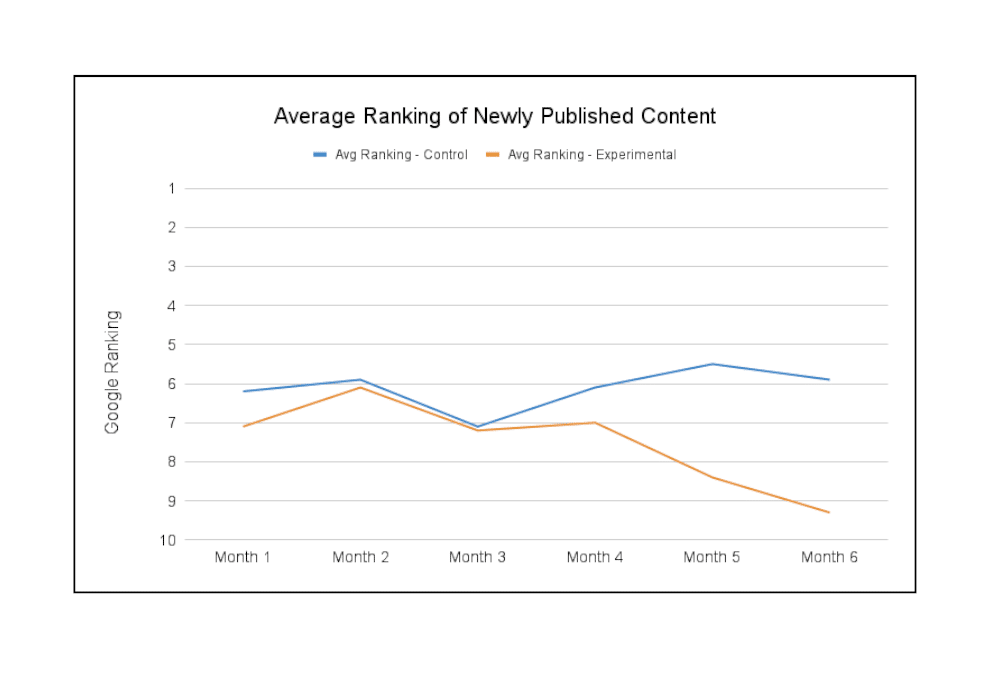B2B campaigns need good metrics — without them, it is difficult, if not impossible, to establish its condition or determine where it needs improvement. But often, B2B campaigns involve so many metrics that it becomes difficult to determine what is actually important versus what isn’t.
In this guide for managers evaluating the progress of their campaigns, we discuss (a) the best B2B lead generation KPIs, (b) why they matter, and (c) what you can do to improve upon each.
| KPI | Benchmark |
| ROI | 748% (Thought Leadership SEO) 36% (PPC) |
| Total # of MQLs | +40% YOY |
| Visitor to Lead Conversion Rate | 2.2% |
| Lead to MQL Conversion Rate | 35% |
| Customer Acquisition Cost (CAC) | $942 (Average Organic) |
| LTV to CAC Ratio | 4:1 |
| Website Traffic | +45% YOY |
B2B Lead Generation KPIs, Explained
Here, we explain what each KPI is and why it matters for B2B lead generation. Then, we offer advice on improving each.
ROI
Return on investment (ROI) compares the total amount invested into the campaign against the overall profits, taking into account external factors that have possibly shifted the balance one way or the other.
This KPI is the ultimate arbiter of how successful a B2B lead generation campaign is. If your B2B campaign has invested more than it has actually made, there’s no clearer indication that your strategy needs adjustment. Remember to adjust for each of your chosen channel’s expected time to break even— comparing PPC and SEO ROI looks very different at 2 months and 12 months.
 Source: B2B Lead Generation Statistics
Source: B2B Lead Generation Statistics
When ROI isn’t meeting your goals, consider investing in higher ROI lead generation channels, such as thought leadership SEO or online webinars. You may also consider outsourcing this work to an experienced firm while you build up your internal team’s capabilities.
Total # of Marketing Qualified Leads (MQLs)
MQLs represent leads, from the target industry, who have expressed a direct interest in your company’s products or services.
MQLs provide a much better indication of a campaign’s success than simply tracking total visitors, clickthroughs, leads, or other higher-funnel indicators. This is because:
- MQLs indicate if you’re reaching actual prospects with your lead generation campaign
- Their demographics give you a better understanding of which markets you are reaching
- Directs you to underperforming KPIs weakening the strength of your campaign.
As with ROI, MQLs alone don’t provide much information but they’re an earlier indicator of potential problems with traffic, targeting, or conversion rates. This means that improving MQLs boils down to looking at your more granular KPIs and fixing problems at a lower level.
Visitor-to-Lead Conversion Rate
Visitor to lead conversion rate refers to visitors to the website who have left their information with the company for further contact.
These leads are different from MQLs in that they might not work in the targeted industry—for example, a B2B campaign that attracts the attention of a private consumer rather than a business.
These leads aren’t as valuable as MQLs, but they do offer a number of benefits, including:
- They let you evaluate how well your website’s pages encourage visitors to reach out.
- Gives a good idea of how appealing your products/services actually are
- Indicating potential additional target audiences to either pivot or expand to
Visitor to lead conversion rate is most easily improved by implementing conversion optimization best practices. In addition, technical problems with the site itself can prevent visitors from reaching out, so it’s a good idea to make sure there are no technical issues with your site’s UX.
Lead to MQL Conversion Rate
Lead to MQL conversion rate measures the number of leads that are in your target audience against the total number of leads generated for the campaign.
As mentioned before, a lead may not work in the desired targeted audience, but some of them do. Sorting out which is which is the next step in the sales funnel. Understanding lead to MQL conversion helps a B2B campaign by identifying both how well your campaign nurtures colder leads and if you’re hitting the desired audience at all.
 Source: B2B Conversion Rate by Industry
Source: B2B Conversion Rate by Industry
The best way to improve lead to MQL conversion rates is to ensure your content both targets the right audience, and speaks to their intent. Investing in lead nurturing programs such as email marketing campaigns will also help push visitors through your marketing funnel.
Customer Acquisition Cost (CAC)
Customer Acquisition Cost (CAC) is the average expense required to gain a new customer.
For example, a B2B campaign may spend money to improve their website, blog content, or manage a marketing campaign on LinkedIn organic. These investments bring in clients that boost the company’s bottom line, but that profit needs to be compared against the investment itself to get an accurate idea of how much the company is actually profiting.
The B2B Channels with the Lowest Average CAC
| Channel | Average CAC |
| Email Marketing | $510 |
| Public Speaking | $518 |
| Webinars | $603 |
| Thought Leadership SEO | $647 |
| LinkedIn Organic | $658 |
Source: CAC by Channel
In that sense, CAC is arguably one of the most important b2b lead generation KPIs to track. It can:
- Tell you if you’re overspending on each customer, and by extension, if your lead generation is inefficient
- Indicate a need for rebudgeting to prioritize low CAC channels.
While the higher CAC paid channels are often fast, they’re also more expensive long-term than low CAC organic ones. The best strategy is to use paid channels in narrowly defined applications, while relying on organic channels for sustainable lead generation.
LTV to CAC Ratio
The LTV to CAC Ratio measures the total profit a company stands to make from a client over the course of their lifetime against the amount required to attain them in the first place.
This number is extremely important for B2B companies, where customer and client relationships often last for years if not decades. At a basic level, this ratio lets you know if your company is overspending if your LTV to CAC ratio that’s too low. If your ratio is extremely high, however, it often indicates that your company is underspending on lead generation and leaving growth opportunities on the table.
To raise your LTV to CAC ratio, you may either invest in lowering your CACs (see above) or raising your average LTV. The best way to do this in a lead generation campaign is to refine your targeting to reach higher value customers.
Website Traffic
Website Traffic refers to how many unique visitors arrive on your website in a given period of time.
Website traffic provides you with a broad understanding of how many people your digital marketing efforts reach. You should also break this number down into first-time and returning visitors to give you a better understanding of how lasting an impression your website makes.
Improving traffic numbers is relatively simple: invest in digital marketing such as PPC and SEO to drive more traffic to your website.
Evaluating Your B2B Lead Generation KPIs
Sometimes it is necessary to contract with an expert for the heavy lifting of evaluating B2B lead generation KPIs. Our agency specializes in B2B SEO, helping companies grow with scaled solutions tailored towards lead generation. If you’d like to schedule a call with a member of our team, you can reach out to us here.



